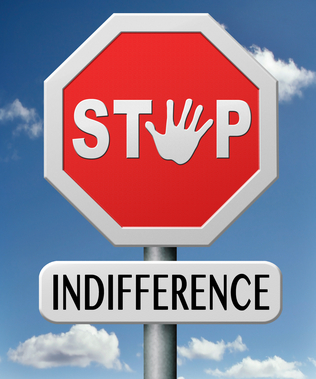The Organizational Effect of Indifference
It is popularly noted through several studies that 68% of customers will leave a product or service due to perceived indifference. So what is perceived indifference? Is when a customer believes you don't care about them or that they aren't important to those providing a product or service. The problem is it doesn't matter if it's true...it's perceived! Whether the indifference is internal or external, the organization is losing valuable people; both employees and customers.
In leadership, indifference is defined as a lack of interest, concern, or sympathy towards others and indifference in an organization often starts at the senior level and trickles down to those selling the product or providing the service. It manifests itself through our intent and actions and often becomes the cultural norm of an organization. Moreover, a management that focuses on problem solving rather than leadership leads to increased bureaucracy, a competitive middle management and indifference among senior management.
Indifference Defined
Indifference in leadership often exhibits itself in several different ways according to Tanmay Vora:
- Indecision
- Lack of Execution
- Unaware of the details
- Inability to learn
- Lack communication skills
- Tolerate low performance
Organizational indifference exhibits itself through phrases such as:
- It's not my job
- I can't help you
- That's how we do things around here
- It's not my fault; someone else was supposed to do that
These types of behaviors typically result in a loss of customers (perceived indifference), employees who no longer care, and long-term stress and burnout among those within an organization. When organizational indifference becomes the cultural norm, those working within will stop looking for opportunities and thriving.
Prevention of Indifference
It is important for leaders to prevent indifference. This can be accomplished though transformational leadership. Transformational leadership styles include influence, motivation, intellectual stimulation and individualized consideration. Using these styles to provide vision, direction, and support will provide the overall framework required to motivate and stimulate a less than enthusiastic workforce.
Additional considerations include communication, praise, recognition, and autonomy. Communicating the organizations vision to those outside senior leadership creates enthusiasm and can provide purpose for everyday activities. Routinely give praise for a job well done, a good idea, or going "above and beyond" normal expectations. Those working within an organization need to feel valued to thrive and succeed. As the culture begins to change, provide recognition and do so publicly. This will incentivize others to do more than the minimum and strive to do more. Finally, empower employees to take action on behalf of an organization so they aren't "second guessing" decisions or actions and provide the next steps should they need additional support. Empowered employees are "out of the box" thinkers who can provide new ideas and find new ways of supporting the company's success.
Final Thoughts
Further, lead from behind so that you can see the whole landscape of the organization. Cultivate those that report to you by providing vision, direction, and support... from the back. This approach empowers employees to cultivate communities of innovation by valuing contributions and allowing them to be a part of "something greater than themselves" and feel there is a common purpose. Finally, keep in mind that this isn't an overnight fix. Cultural change can take months or sometimes years. Overcoming perceived indifference within an organization means overcoming years of organizational behaviors that created an environment of indifference in the first place.
© Darrielle Ehrheart | September 28, 2014
Back to Home >>